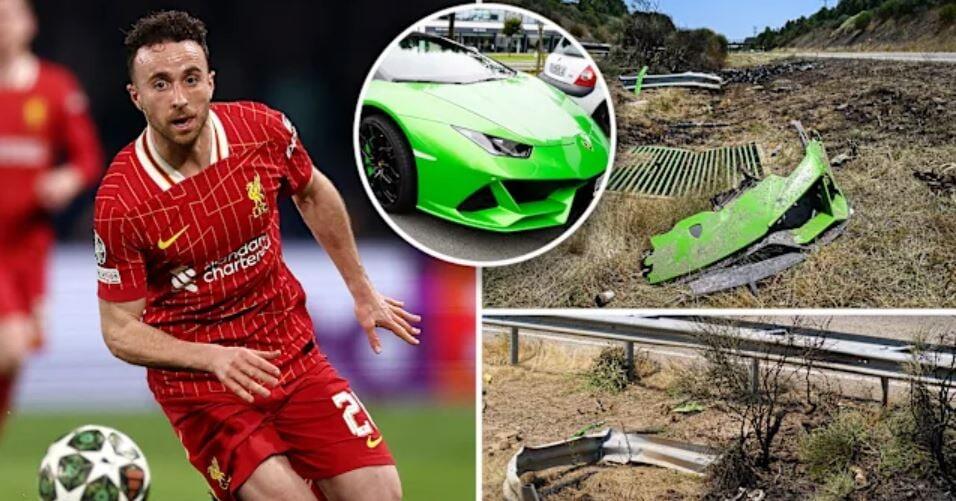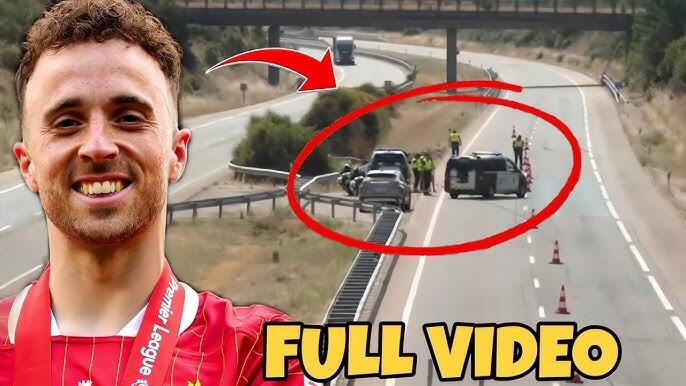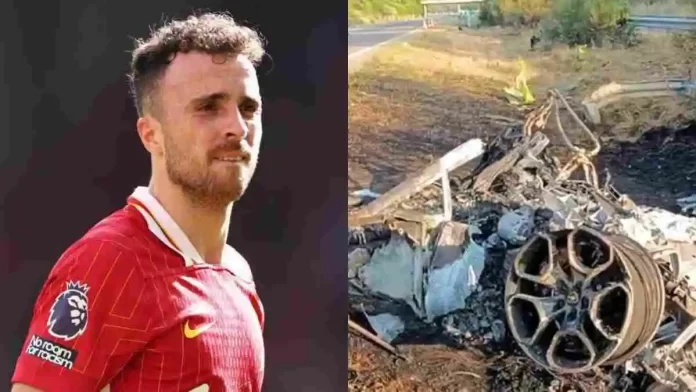EXCLUSIVE VIDEO: Lorry Driver at Jota Crash Scene Reveals Police Told Him Not to Share What He Saw
The tragic car accident that claimed the lives of Liverpool FC star Diogo Jota and his brother André Silva on July 10, 2025, has taken a dramatic turn. A Portuguese lorry driver, Jose Azevedo, who was among the first at the scene and filmed the aftermath, has come forward with a shocking claim: police instructed him not to share what he witnessed, including his assertion that Jota’s Lamborghini was not speeding at the time of the crash. This revelation, coupled with Azevedo’s viral video footage, contradicts the preliminary police report and has sparked widespread controversy. This article delves into the details of the incident, Azevedo’s explosive claims, the police’s response, and the implications for the ongoing investigation into one of football’s most devastating tragedies.

The Crash That Shocked the World
The fatal accident occurred around 12:30 a.m. on the A-52 motorway near Cernadilla, Zamora, in northwestern Spain. Diogo Jota, the 28-year-old Portuguese forward for Liverpool FC, and his 25-year-old brother André Silva, a professional footballer for Penafiel, were killed when their Lamborghini Huracan Evo Spyder veered off the road and burst into flames. According to the Spanish Guardia Civil, the crash was caused by a tyre blowout while the vehicle was overtaking another car, leading to a loss of control and a fiery wreck. The brothers were reportedly traveling from Porto to Santander to catch a ferry to England, as Jota had been advised against flying due to recent lung surgery.
The preliminary police report, released days after the crash, suggested that excessive speed was a likely factor, with tyre marks indicating the vehicle may have exceeded the 120 km/h (75 mph) speed limit. Authorities also stated that “all tests carried out” pointed to Jota as the driver. This narrative shaped early media coverage, framing the incident as a tragic consequence of speeding. However, Azevedo’s account has cast doubt on these findings, raising questions about the investigation’s transparency and accuracy.
The Lorry Driver’s Bombshell Account
Jose Azevedo, a Portuguese lorry driver who frequently travels the A-52, was among the first to arrive at the crash site. In a selfie video recorded from his lorry’s cab and shared with Portuguese media, Azevedo provided a detailed account of what he witnessed, directly challenging the police’s claims. “I drive this road Monday through Saturday, and I know it’s a terrible place. It’s a dark road. I could see the make and colour of the car,” he said. Crucially, he insisted, “Diogo Jota was not speeding. I saw the car before it crashed, and it wasn’t going fast.” Azevedo’s video of the burning Lamborghini, which shows his lorry’s tachograph displaying his name and a cracked windscreen, has been cited as proof of his presence at the scene.

In a startling revelation, Azevedo claimed that police at the scene instructed him not to share what he saw, warning him against discussing the incident or releasing his footage. “They told me to keep quiet, not to tell anyone what happened,” he said in the video, which has since gone viral, amassing millions of views on X. Azevedo expressed frustration, stating, “I stopped, grabbed the fire extinguisher, and tried to help, but there was nothing I could do. The impact was too severe.” He emphasized his “clear conscience” and offered condolences to Jota’s family, highlighting the emotional toll of witnessing the tragedy.
The footage, described as “rambling” by some outlets, shows the charred remains of the Lamborghini and debris scattered along the road, with fire spreading to nearby vegetation. While it does not conclusively prove or disprove the speed of Jota’s vehicle, Azevedo’s testimony has resonated with fans and skeptics who question the police’s rush to attribute the crash to speeding.
Police Response and Investigation Challenges
The Spanish Guardia Civil has stood by its preliminary findings, stating that forensic evidence, including tyre marks extending 100 meters from the impact site, suggests excessive speed. A spokesperson noted that the investigation is ongoing, with a final report to be submitted to a court in Puebla de Sanabria. The police have not directly addressed Azevedo’s claim that they instructed him to withhold his account, but they have emphasized that their conclusions are based on “objective evidence,” including traffic camera footage and vehicle data analysis.
Azevedo’s allegations have highlighted the complexities of accident investigations, particularly in high-profile cases. Eyewitness accounts, while valuable, can be subjective and influenced by factors like darkness, stress, or limited visibility. The A-52 stretch where the crash occurred is known for its challenging conditions, with Azevedo describing it as a “terrible place” due to its darkness and poor road quality. Spanish road safety expert Javier Lopez Delgado has pointed to “multiple factors,” including road conditions and the tyre blowout, suggesting that speed alone may not explain the crash.

The claim that police attempted to suppress Azevedo’s account has fueled speculation about external pressures or biases in the investigation. On X, users have expressed outrage, with some alleging a cover-up to protect the road’s reputation or deflect blame from systemic issues like poor infrastructure. “Why tell a witness to stay quiet? What are they hiding?” one post read. Others have urged caution, noting that Azevedo’s account lacks corroboration and that police may have been protecting the investigation’s integrity.
Public and Football Community Reaction
The football world continues to mourn Jota and Silva, with tributes pouring in from teammates, rival players, and global figures. Liverpool FC described the loss as “unfathomable,” with manager Arne Slot calling Jota “the essence of a Liverpool player.” Fans have gathered at Anfield, leaving flowers, scarves, and messages, including a placard reading “Diogo lives forever.” Cristiano Ronaldo, Jota’s Portugal teammate, wrote, “It doesn’t make sense. We were just together with the national team.” The brothers’ funeral in Gondomar, Portugal, was attended by Liverpool players and dignitaries, underscoring their impact.
The controversy surrounding Azevedo’s claims has amplified public scrutiny of the investigation. Fans on X have rallied behind the lorry driver, with posts like, “He’s risking everything to tell the truth. Respect.” Others have criticized the police for allegedly silencing a witness, with one user stating, “If Jota wasn’t speeding, they need to come clean about what really happened.” The polarized reactions reflect a broader distrust in official narratives, particularly in the wake of a tragedy involving a beloved public figure.
Implications for Road Safety and Transparency
Azevedo’s account raises critical questions about transparency in accident investigations and the role of eyewitness testimony. The instruction to withhold his observations, if true, suggests potential mishandling or an attempt to control the narrative, which could erode public trust. Road safety experts have called for a thorough investigation that considers all factors, including the condition of the A-52, which saw another serious accident involving a 60-year-old woman just hours before Jota’s crash.
The incident also underscores the dangers of high-performance vehicles like the Lamborghini Huracan, which has a top speed of 200 mph. While a tyre blowout could cause a crash at any speed, experts note that high speeds exacerbate the consequences. However, Azevedo’s claim that the car was not speeding shifts the focus to other potential causes, such as road conditions or mechanical failure, which merit further scrutiny.
Moving Forward
As the investigation continues, Jota’s family, including his wife Rute Cardoso and three young children, faces unimaginable grief. The football community remains united in honoring Jota’s legacy, with his 65 goals in 182 appearances for Liverpool and 14 goals in 49 caps for Portugal cementing his status as a star. The truth about the crash—whether speed, road conditions, or other factors played a role—will be crucial for closure and preventing future tragedies.
Azevedo’s decision to defy the alleged police instructions and share his account has sparked a global conversation. His video, now a focal point of the controversy, may pressure authorities to release additional evidence, such as traffic camera footage or vehicle data, to clarify the circumstances. For now, the world waits for answers, hoping for justice and transparency in memory of Diogo Jota and André Silva.
